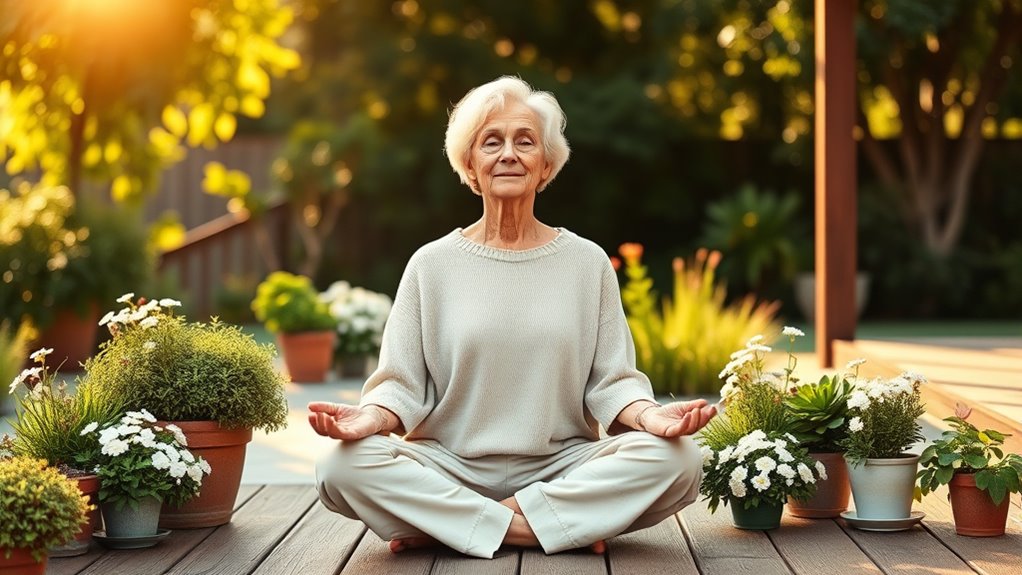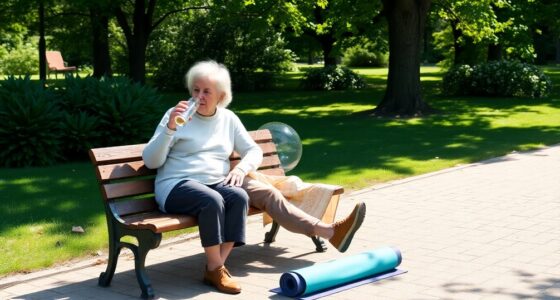Practicing mindfulness and meditation can help you reduce stress, improve your mood, and boost your overall health as you age. Techniques like guided meditation, breathing exercises, and body scans are easy to follow and fit into daily life. These practices can also lower inflammation, support your mental clarity, and strengthen your immune system. If you want to discover simple ways to incorporate mindfulness into your routine, explore the helpful ideas ahead.
Key Takeaways
- Mindfulness and meditation improve seniors’ mental health by reducing depression, anxiety, and enhancing emotional resilience.
- Various techniques like guided meditation, breathing exercises, and gentle movement are suitable for seniors.
- Regular practice boosts cognitive functions, sleep quality, immune health, and reduces cellular aging.
- Incorporating mindfulness into daily routines can be simple, such as focusing on sensory experiences or during chores.
- Accessible resources like apps, community classes, and online videos support seniors in establishing a meditation practice.
Benefits of Mindfulness and Meditation for Older Adults
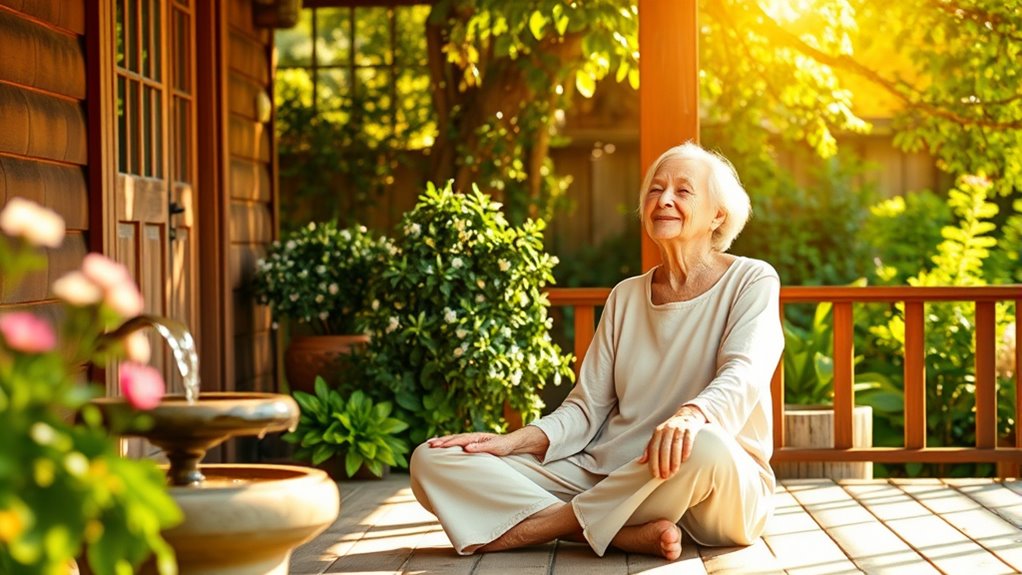
Have you ever wondered how mindfulness and meditation can improve your life as you age? These practices offer numerous benefits, especially for your physical health.
Regular mindfulness can reduce symptoms of depression and anxiety, helping you feel more balanced and focused. It also enhances cognitive functions like memory and decision-making by increasing activity in brain regions responsible for these skills.
Practicing mindfulness reduces depression and anxiety while boosting memory and decision-making skills.
Additionally, mindfulness-based interventions boost your immune system, lowering inflammatory markers such as C-reactive protein, and promote better overall physical health.
Engaging in these practices can lead to improved sleep quality, greater emotional resilience, and a stronger sense of purpose and security.
Scientific studies support that consistent mindfulness and meditation help you enjoy a healthier, more vibrant life as you age.
Dog quotes for reflection and humor can serve as a delightful reminder of the importance of companionship and joy in your daily routine.
Types of Meditation Suitable for Seniors
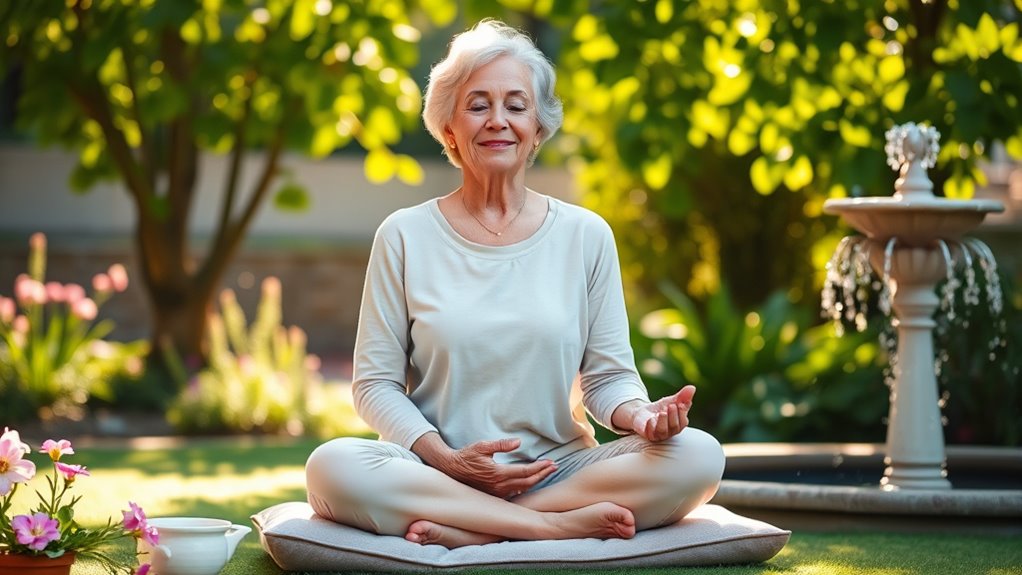
There are several types of meditation that are particularly well-suited for seniors, offering flexibility and ease of practice. Guided meditation is popular because it provides clear instructions, often via recordings or a teacher, helping you stay focused and relaxed.
Breathing exercises, like belly breathing or death breathing, promote relaxation and improve respiratory function. Incorporating specialized breathing techniques can further enhance lung capacity and overall breathing efficiency. Utilizing diaphragmatic breathing can be especially beneficial for seniors with compromised lung health.
Visualizations, such as guided imagery, involve imagining calming scenes to enhance mental calmness and emotional well-being. These practices can be especially helpful for those managing health conditions or mobility challenges.
Mindfulness meditation encourages you to pay attention to the present moment with acceptance, helping to reduce anxiety and improve mental clarity. It can be adapted to accommodate mobility limitations, making it accessible for many seniors.
Additionally, practicing gentle movement meditation, such as tai chi or qi gong, can be beneficial for seniors with mobility limitations, combining physical activity with mindfulness. Engaging in these practices can also support joint health and overall physical well-being.
Simple Breathing Techniques to Reduce Stress
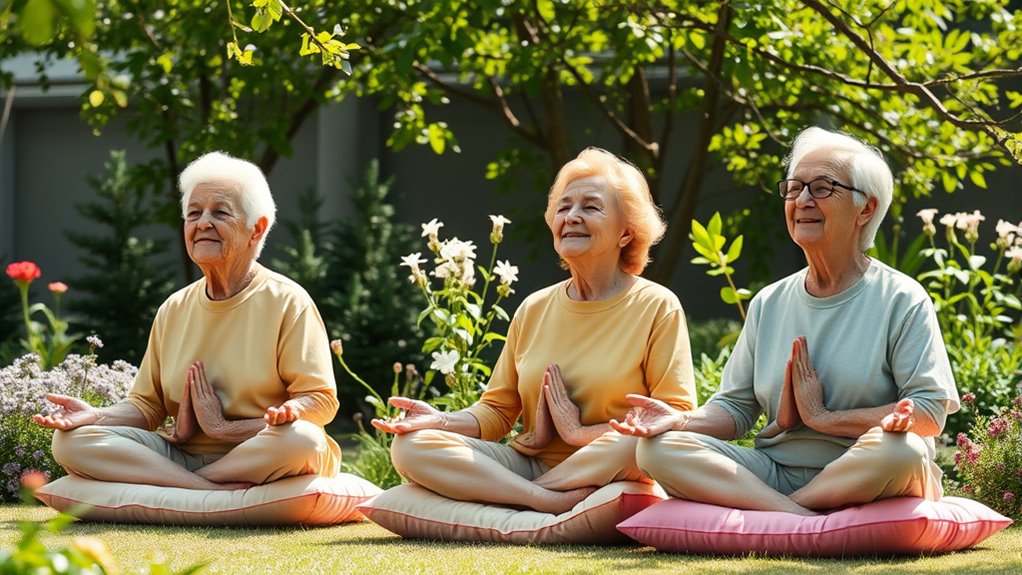
Simple breathing techniques are a practical way to reduce stress and promote relaxation anytime you need it. By focusing on your breath, you can cultivate mindfulness and calm your nervous system.
Belly breathing is especially effective; place one hand on your chest and the other on your stomach. Inhale deeply for four seconds, allowing your diaphragm to expand, then hold briefly before slowly exhaling. This practice encourages mindfulness, which helps to center your thoughts and reduce anxiety. Incorporating best anime movies into your relaxation routine can also provide a mental escape and uplift your mood.
Paying attention to the sensation of your hands during each breath enhances attention, helping to release tension. Practicing slow, deliberate breathing anywhere—whether at home or outside—can quickly lower stress levels. Engaging in these exercises regularly can also help to reduce cortisol and support overall mental and physical relaxation.
Regularly engaging in these exercises reduces cortisol and supports overall mental and physical relaxation. These simple techniques are easy to incorporate into your daily routine for immediate stress relief. Quotes about guidance and support can serve as motivation to stay committed to your mindfulness practice.
Body Awareness and Body Scan Practices
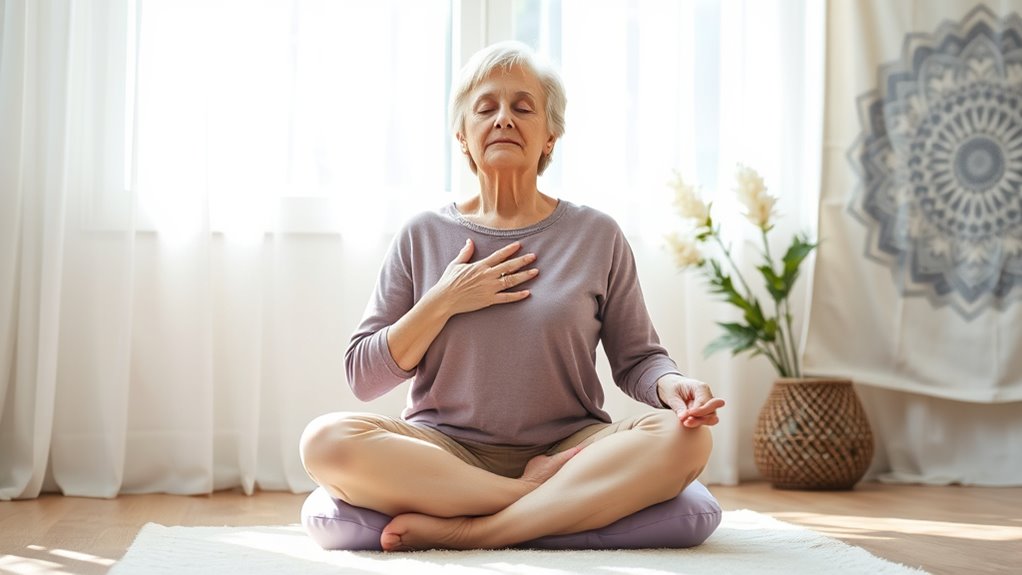
Body scan practices help you notice sensations from your head to your toes, fostering relaxation and present-moment awareness. When you lie on your back with palms facing up, it’s easier to connect with your body and release tension. Regularly practicing these exercises can improve your physical comfort and emotional well-being. Incorporating scheduled sessions during retail hours can help establish a consistent routine that fits your daily life. Using best knitting patterns for olive green sweaters as a mindful activity can also enhance focus and relaxation during your practice. Exploring contrast ratio adjustments can inspire new ways to deepen your focus and mindfulness, creating a calming routine that supports your overall well-being. Understanding the importance of sustainable foraging practices can also promote mindfulness by fostering respect for nature during your outdoor activities.
Enhancing Physical Relaxation
Practicing body awareness through the body scan technique can considerably enhance physical relaxation by guiding you to focus on different parts of your body, from head to toe. This process helps you become more attuned to bodily sensations, increasing relaxation and reducing tension. Incorporating mindfulness strategies into your routine can further deepen the calming effects and promote overall well-being. Lying on your back with palms facing upward encourages a state of openness and receptivity, making it easier to notice areas of discomfort or tightness. Regular body scan exercises lower stress levels and improve sleep quality in seniors. Additionally, understanding how UV exposure risks are managed can inspire new ways to engage with relaxing activities through technology. Recognizing the importance of emotional support can also help reinforce a sense of safety and comfort during your mindfulness practices. Exploring air purification technology can create a healthier environment that supports your relaxation and overall health.
Cultivating Present-Moment Awareness
Cultivating present-moment awareness through body scan practices encourages you to pay close attention to physical sensations from head to toe. This mindfulness exercise helps you stay grounded and fully present, fostering a deeper connection to your body. Research indicates that mindfulness exercises like body scans can significantly enhance emotional regulation and reduce anxiety. You can perform a body scan while lying down or sitting comfortably, focusing on each area and noticing sensations like tension, warmth, or discomfort. Regular practice increases somatic awareness, making it easier to identify stress or tension early. Scientific studies show that body scan meditation can reduce stress, improve sleep, and ease chronic pain, especially for seniors. Additionally, understanding newborn sleep patterns can help caregivers develop effective routines that promote restful sleep. Developing an awareness of subconscious messages can further deepen your mindfulness practice and understanding of your emotional states. Incorporating body awareness into your daily routine supports mental clarity and physical relaxation, helping you stay centered and present throughout the day. Furthermore, integrating goal setting techniques into your mindfulness routine can enhance your motivation and progress in personal growth. Being mindful of the noise levels of modern heat pumps in your environment can also contribute to a more peaceful and comfortable living space.
Incorporating Mindfulness Into Daily Activities
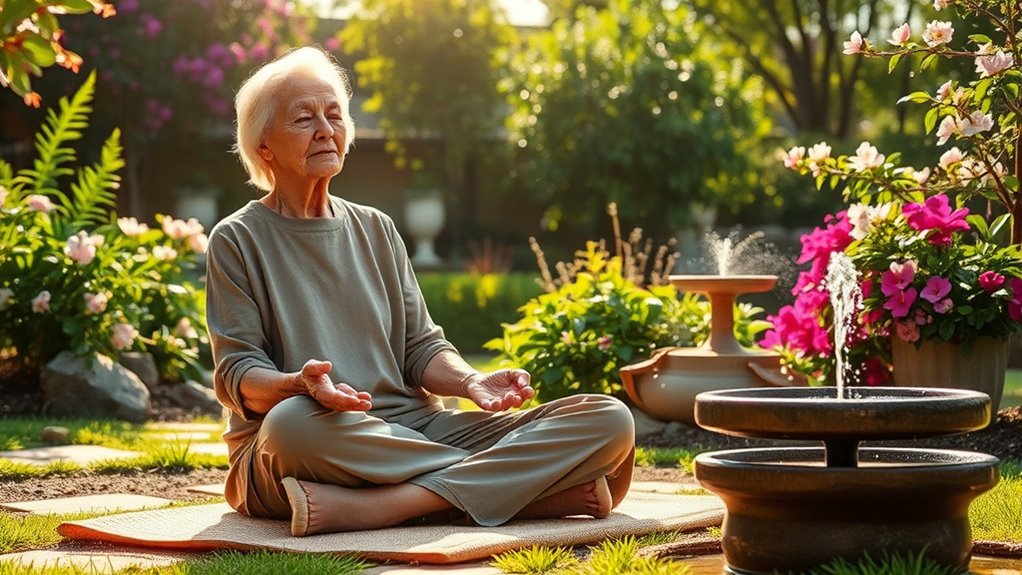
Incorporating mindfulness into your daily routines can seamlessly enhance your sense of presence and well-being. You can practice mindfulness during simple activities like drinking coffee, paying close attention to its aroma, warmth, and taste.
When walking outdoors, focus on the sensation of your feet on the ground and the sounds around you. Schedule short meditation sessions, such as guided breathing or body scans, to create consistency.
Use reminders on your phone or calendar to pause and take deep breaths, embedding mindfulness into everyday life. Additionally, turn chores like cooking or gardening into moments of present-moment awareness by concentrating fully on each step or sensation.
Engaging in mindful listening or observing nature during walks can deepen sensory awareness and promote relaxation throughout your day.
Guided Meditations and Resources for Beginners
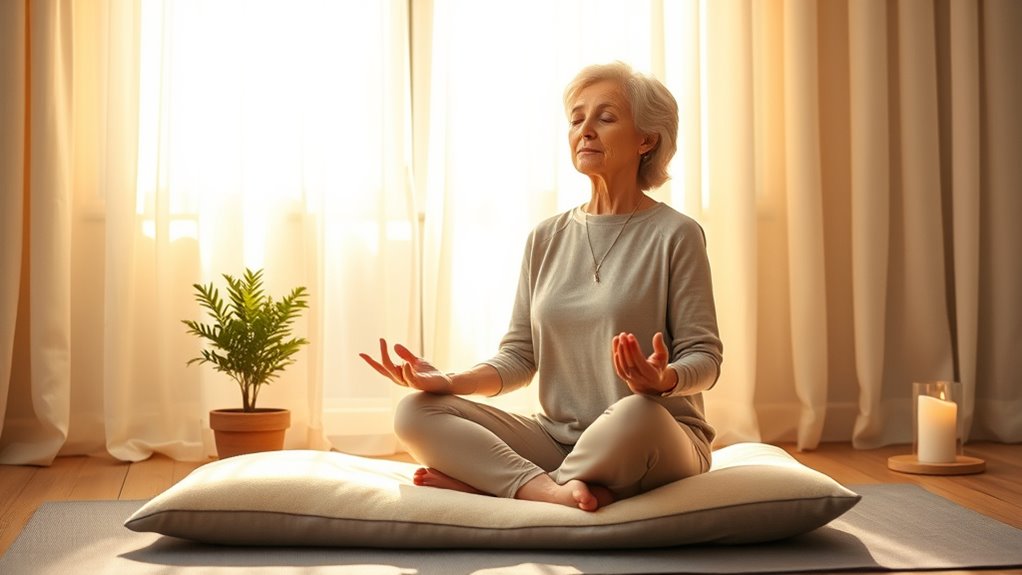
Guided meditations are easy to access and designed specifically for beginners, helping you get started with confidence.
You can find free or low-cost options on popular platforms like YouTube, Headspace, and Waking Up, making it simple to try meditation without a big commitment.
Many community centers also offer classes tailored for seniors, providing additional support and guidance.
Accessible Guided Sessions
Accessible guided meditation sessions are readily available to seniors through various apps, online platforms, and local programs. You can find guided meditations on apps like Headspace, Waking Up, or on YouTube, offering free and paid options designed for beginners.
Many community centers and senior organizations also provide in-person or virtual mindfulness activities tailored for older adults. These guided sessions typically include step-by-step instructions on breathing, body awareness, and mindfulness techniques, making them easy to follow.
Research shows that guided meditation is more effective than unguided practice in reducing depression and anxiety among seniors. With these resources, you can establish a regular meditation routine with expert guidance, making mindfulness accessible and manageable at any experience level.
Tailored for Beginners
Starting your meditation journey is easier than you might think, thanks to resources specifically designed for beginners. Guided meditations offer step-by-step instructions that help you practice mindfulness with confidence. Many apps like Headspace and YouTube provide beginner-friendly sessions lasting just 5 to 10 minutes, making it simple to incorporate meditation into your daily routine. Plus, organizations like NCOA offer free resources tailored for seniors, ensuring accessibility. Visual and audio-guided options accommodate different needs, including visual impairments or mobility limitations. To help you get started, here’s a quick overview:
| Resource Type | Benefits | Accessibility |
|---|---|---|
| Apps (Headspace, Calm) | Easy to follow, portable | Visual and audio options |
| YouTube guided meditations | Free, extensive variety | Suitable for all needs |
| Community programs | Supportive environment | Designed for seniors |
| Short daily sessions | Builds sustainable practice | Time-efficient |
Free and Low-Cost Options
Are you looking for effective ways to explore mindfulness without spending a lot? Luckily, there are plenty of free meditation options designed for seniors and beginners.
Organizations like the National Council on Aging (NCOA) offer free guided meditation resources tailored to older adults, making it easy to start practicing.
Popular apps such as Insight Timer, Waking Up, and Headspace also provide free or low-cost guided meditations, often with beginner-friendly sessions.
YouTube is another excellent resource, hosting countless free guided meditation videos led by experienced instructors that you can follow at your own pace.
Community and senior centers frequently offer free or affordable meditation classes or groups.
Additionally, many online platforms provide downloadable audio files and virtual sessions at little or no cost to support your mindfulness journey.
Enhancing Emotional Well-Being With Mindfulness
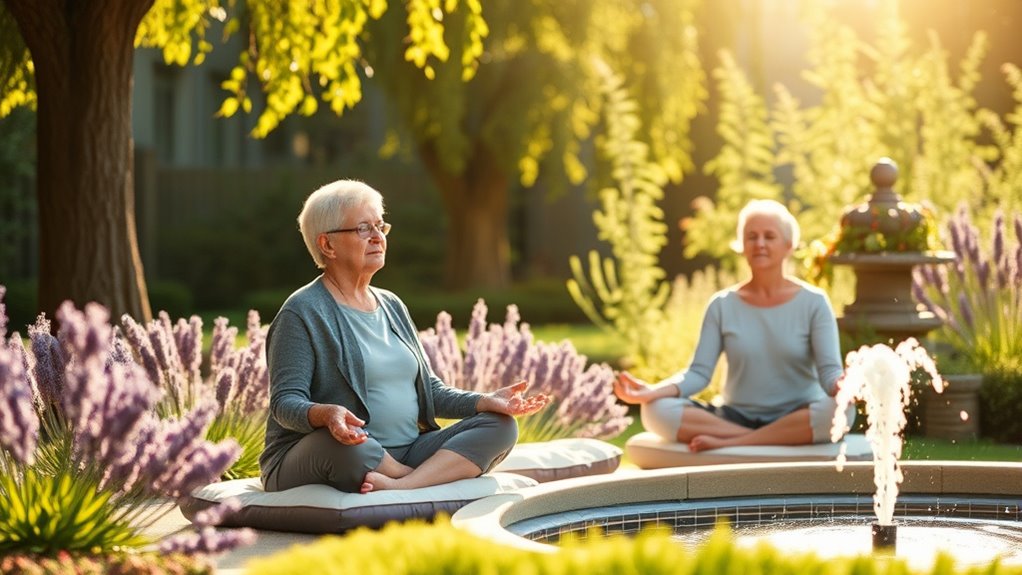
Practicing mindfulness can substantially enhance your emotional well-being as you age. By engaging in regular mindfulness routines, you can reduce symptoms of depression and anxiety, strengthening your mental health.
Guided meditation sessions help decrease feelings of loneliness and foster a sense of connection. Incorporating positive affirmations and gratitude journaling into your practice boosts your mood and creates a sense of purpose.
Mindfulness techniques also teach you to manage emotional responses to stress by encouraging present-moment awareness and acceptance. As you continue this practice, you’ll likely notice increased feelings of happiness, contentment, and emotional stability over time.
These benefits demonstrate how mindfulness can be a powerful tool to support your emotional resilience, helping you navigate the challenges of aging with greater ease and well-being.
Physical Health Benefits of Meditation in Aging

Meditation can considerably boost your heart health by improving blood flow and lowering inflammation.
Regular practice also helps reduce blood pressure and strengthen your immune system. These benefits support healthier aging and contribute to your overall physical well-being.
Improved Heart Function
As you embrace mindfulness practices, you can experience tangible improvements in your heart health. Mindfulness enhances blood flow to the brain, supporting overall cardiovascular function in older adults.
Regular meditation reduces neuroinflammation, which is linked to the progression of heart disease. It also improves neurovascular control, helping to regulate blood pressure and lower hypertension risks.
By calming the mind, meditation decreases stress hormones like cortisol, which directly benefit your cardiovascular system.
Additionally, mindfulness-based interventions have been shown to improve heart rate variability, indicating a more resilient and adaptable heart.
These benefits work together to strengthen your heart’s health, making mindfulness an effective tool for maintaining and improving cardiovascular function as you age.
Reduced Inflammation Levels
Building on the heart health benefits of mindfulness, reducing inflammation plays a key role in aging gracefully. Meditation helps lower inflammation by decreasing levels of C-reactive protein, a marker linked to systemic inflammation.
Regular meditation increases telomere activity, which is associated with reduced cellular aging and inflammation. Studies show that mindfulness reduces pro-inflammatory cytokines, leading to lower overall inflammation in older adults.
By practicing meditation, you can also boost your immune function, helping your body fight chronic inflammation common in aging. Additionally, mindfulness-based interventions support neurovascular health, aiding in the regulation of inflammatory processes.
Incorporating meditation into your routine can markedly diminish inflammation levels, promoting healthier aging and improved overall well-being.
Creating a Consistent Meditation Routine
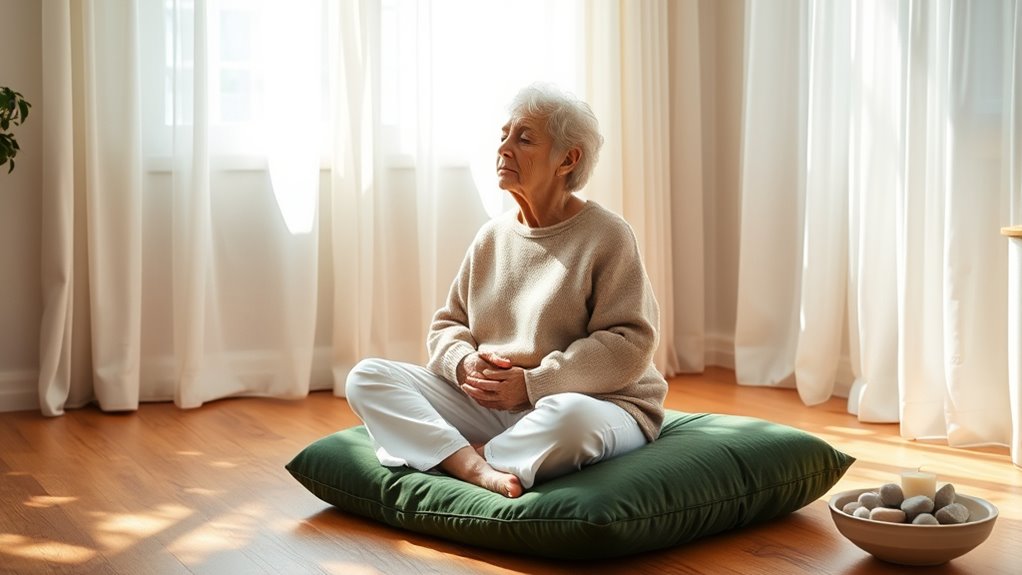
Creating a consistent meditation routine can greatly enhance its benefits and make it easier to stick with over time. To develop a consistent practice, find a quiet, dedicated space and set aside the same time each day.
Starting with short sessions of 5-10 minutes allows you to build familiarity and comfort. As you progress, gradually increase your meditation duration.
Using guided meditations or apps designed for seniors can provide structure and support your routine. Setting reminders or alarms helps reinforce daily practice.
Tracking your progress with a journal or calendar keeps you motivated and allows you to observe the positive effects of mindfulness meditation over time.
Consistency is key to experiencing the full benefits of meditation in your everyday life.
Overcoming Common Challenges in Practicing Mindfulness
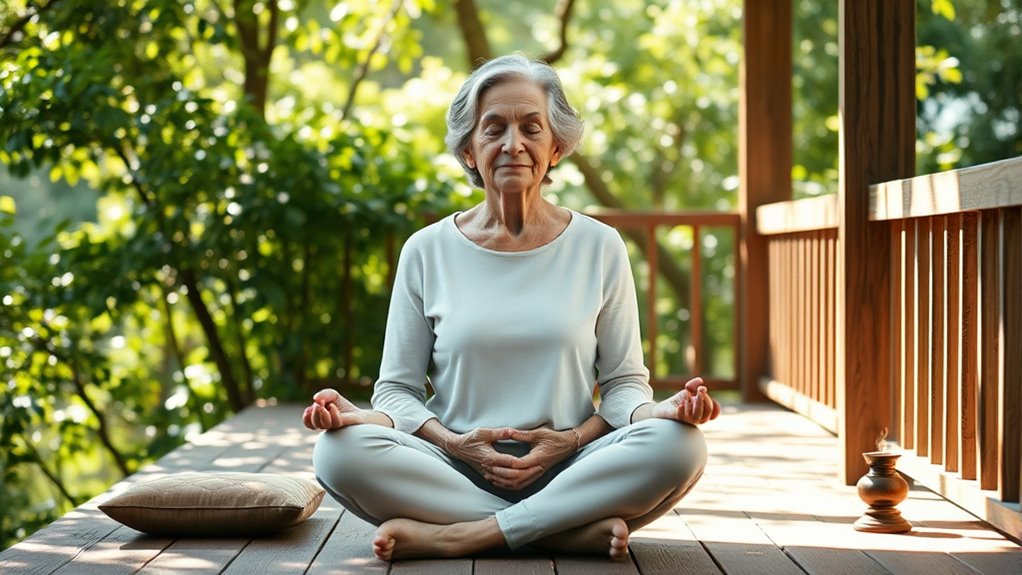
Practicing mindfulness regularly can sometimes present challenges, especially for seniors facing physical or mental barriers. To overcome these, try shorter sessions and gentle modifications. For example, seated or guided audio meditations can help those with limited mobility or visual impairments. Remember, anxiety about doing practice “correctly” isn’t a barrier; any effort offers benefits, so approach with a non-judgmental attitude. If fatigue or health issues interfere, incorporate brief mindfulness exercises into daily routines. Joining group classes or using online resources can also provide guidance and social connection. Here’s a quick overview:
| Challenge | Solution | Tips |
|---|---|---|
| Maintaining focus | Guided meditations | Use timers for short practice |
| Physical discomfort | Gentle modifications, seated practice | Listen to your body |
| Feelings of impatience | Shorter sessions, patience, compassion | Be kind to yourself |
| Visual or mobility issues | Audio guides, seated practice | Accessibility tools |
| Lack of guidance | Group classes, online resources | Seek community support |
Frequently Asked Questions
How Do You Teach Mindfulness to the Elderly?
You teach mindfulness to the elderly by starting with simple, accessible techniques like breathing exercises, body scans, or guided imagery.
Keep sessions short, around five minutes, to avoid overwhelm.
Use clear, slow instructions and visual aids, and create a supportive environment through group classes or individual guidance.
Be patient, encourage repetition, and celebrate progress to help them build confidence and enjoy the practice over time.
What Does the Bible Say About Mindfulness Meditation?
They say, “Still waters run deep,” and the Bible reflects this truth. It encourages you to be still and recognize God’s presence, like in Psalm 46:10.
Biblical meditation involves repeating scripture and focusing on positive thoughts, similar to mindfulness.
Passages like Philippians 4:8 guide you to focus on what’s pure and true.
These practices foster inner peace and deepen your spiritual awareness through quiet reflection and prayer.
Is There a Totally Free Meditation App?
You’re wondering if there’s a totally free meditation app. Yes, several apps offer completely free content, like Insight Timer, which has over 100,000 guided meditations, music, and courses.
Smiling Mind is another excellent option, developed by psychologists, with tailored programs for older adults.
Many community centers and health organizations also recommend free resources. You can explore these to start or deepen your meditation practice without any cost.
How to Meditate for the Elderly?
Imagine your mind as a gentle lake, calm and inviting. To meditate, find a cozy spot where you won’t be disturbed. Sit or lie down comfortably, close your eyes, and focus on your breath.
Inhale deeply, hold briefly, then exhale slowly. Use simple tools like guided videos or apps designed for seniors, gradually increasing your practice time.
With each session, your mind becomes a tranquil pond, reflecting peace.
Conclusion
By embracing mindfulness and meditation, you can open a treasure trove of benefits that enhance your quality of life. While it may take time to see results, remember that patience is a virtue—practice consistently, and you’ll find your mind and body grow stronger. Don’t throw in the towel when challenges arise; instead, keep your eye on the prize. With dedication, you’ll discover that the journey to well-being is truly worth it.
